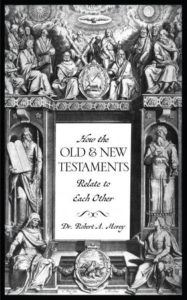
The book entitled How the Old & New Testaments Relate to Each Other by Dr. Robert A. Morey can be obtained at Xulon Press.

How the Old & New Testaments Relate to Each Other — Part 1
How the Old & New Testaments Relate to Each Other — Part 2
How the Old & New Testaments Relate to Each Other — Part 3
How the Old & New Testaments Relate to Each Other — Part 4
Law and Gospel — 09/05/1982 (Discussion with Dr. Robert A. Morey & Rev. John G. Reisinger (03/21/1924 – 12/17/2018)
Note: There were 4 Covenants given by Yahweh: 1. The Noahic Covenant, 2. The Abrahamic Covenant (the land or so-called Palestinian Covenant is part of the Abrahamic Covenant, not a separate Covenant), 3. The Mosaic Covenant (the so-called Davidic Covenant and Solomon are personal applications of the Mosaic Covenant, therefore, they are not separate Covenants), 4. The New Covenant (everlasting).
According to Dr. Robert A. Morey in his book entitled How the Old and New Testament Relates to Each Other, page 70, “Most dispensationalists simply assert that there are eight (8) covenants but they never tell us how they relate one to another. Neither do they supply any exegetical proof for the existence of the Edenic and Adamic covenants. I have yet to receive an answer to the question, ‘Since the Bible nowhere mentions an Edenic or Adamic covenant, where is the exegetical justification for listing them?’ “ Many dispensationalists use the Scofield Reference Bible to prove such nonsense. Covenant theology also makes the mistake of denying the diversity of the biblical covenants. There is nothing in Scripture which speaks of an “everlasting covenant of grace” made in heaven between the Father and the Son. A covenant is a space/time event and entered in with a specific person. Only the New Covenant is called “everlasting” because it will never become obsolete like the Old Covenant or Mosaic Covenant (Jer. 32:40 & Heb. 13:20). Charles Hodges listed 4 covenants in the Bible. It depends on how you divide things.
“However, in the past, when you did not know God, you were slaves to things that are not really gods at all. But now you turn back again to those powerless and bankrupt basic principles? Why do you want to become their slaves all over again? You are observing days, months, seasons, and years. I am afraid for you, lest somehow my work for you has been wasted!” (Galatians 4:8-11 ISV.) The Old Covenant (a legal contract made in time/space) was defective, not the Old Testament (a literary document). The Israelites were under a tutor/law–they were told how to dress, what to eat, how to cut their hair, how to worship by a highly structured liturgy, etc. This is not in the New Testament. The New Testament gives believers moral directives to apply to all of life, but does not give us minute directions as in the Old Testament. Galatians states:
“Tell me, those of you who want to live under the law: Are you really listening to what the law says? For it is written that Abraham had two sons, one by a slave woman and the other by a free woman. Now the son of the slave woman was conceived according to the flesh, but the son of the free woman was conceived through a promise. This is being said as and allegory, for these women represent two covenants. The one woman, Hagar, is from Mount Sinai, and her children are born into slavery. Now Hagar is Mount Sinai in Arabia and corresponds to present-day Jerusalem, because she is in slavery along with her children. But the heavenly Jerusalem is the free woman, and she is our mother”. (Galatians 4:21-26 ISV.)
Typical examples of legalism (under the law—see Rom. 3:20, 28; 7:1-6; Gal. 3:1-5; 4:4-5). For further information, see FAQ Tab#31.
